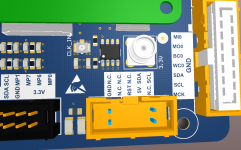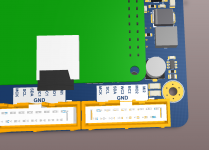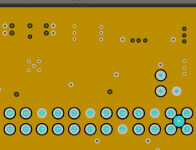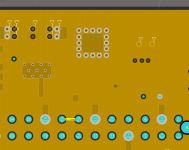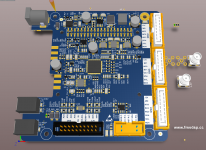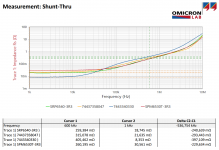One option, I think, would be PCM2707 and SRC4192.
There are better options for both I think (I don't know how to program any "cpu" for the USB Interface though, and AD1896A SRC/ASRC is a bit more costly than the SRC4192).
For vreg, in accordance with the guidelines, I thought LM2594-5.0 & LM2594-3.3 might work. Here to there are better options, but parts cost will be quite high even with parts suggested above.
I am not aware of any USB Interface with ASRC in one IC, I have not really looked into that as I haven't needed to in the past.
I looked at farnell (element14) as I believe that is available to most?
I've never done any work with switching regulators as keeping power consumption low has not been that high a priority for me.
Though following layout suggestions etc in the datasheet isn't really rocket surgery
Sidenote:
Though I fully understand the need for "plug-n-play" modules, the cheaper option (atleast I think so) would be something like xmos USB to I²S or similar. Given that can work slaved to the DSP that is.
Back to the matter at hand, any ideas or input?
Better, more suitable device I can look at?
ATM, as I wrote, I'm limited in the time I'm able to read/do any work on the PC. But my neck gets better every day
There are better options for both I think (I don't know how to program any "cpu" for the USB Interface though, and AD1896A SRC/ASRC is a bit more costly than the SRC4192).
For vreg, in accordance with the guidelines, I thought LM2594-5.0 & LM2594-3.3 might work. Here to there are better options, but parts cost will be quite high even with parts suggested above.
I am not aware of any USB Interface with ASRC in one IC, I have not really looked into that as I haven't needed to in the past.
I looked at farnell (element14) as I believe that is available to most?
I've never done any work with switching regulators as keeping power consumption low has not been that high a priority for me.
Though following layout suggestions etc in the datasheet isn't really rocket surgery
Sidenote:
Though I fully understand the need for "plug-n-play" modules, the cheaper option (atleast I think so) would be something like xmos USB to I²S or similar. Given that can work slaved to the DSP that is.
Back to the matter at hand, any ideas or input?
Better, more suitable device I can look at?
ATM, as I wrote, I'm limited in the time I'm able to read/do any work on the PC. But my neck gets better every day
I think that for usb module, either xmos, or audio widget is way to go.
Clocking them from the DSP, with Fs fixed at the PC side.
The point of the usb I2S module is not to have asrc at all. Spit out audio data at the command of nice local clock.
Anyway, if you'd like to try 2707, theres ASRC in ADAU1452 already.
Given the quality of 2707, and that the output goes to ASRC anyway, I would not bother much with the design. Well actually I'd just buy module from somewhere on the internet. No point in spending time on this one. Multichannel USB I2S on the other hand..
I agrre with you that there are cheaper options already aviable - and its way to go at least for now. The "problem" is that most of them are stereo only, and alredy have clock on board, so you pay for clock you dont use and need to hack it. No the othere side I have absolutely no idea how many people would like to run digital filters on a multichannel home cinema setup.
Dont push yourself, and good luck with your neck
Clocking them from the DSP, with Fs fixed at the PC side.
The point of the usb I2S module is not to have asrc at all. Spit out audio data at the command of nice local clock.
Anyway, if you'd like to try 2707, theres ASRC in ADAU1452 already.
Given the quality of 2707, and that the output goes to ASRC anyway, I would not bother much with the design. Well actually I'd just buy module from somewhere on the internet. No point in spending time on this one. Multichannel USB I2S on the other hand..
I agrre with you that there are cheaper options already aviable - and its way to go at least for now. The "problem" is that most of them are stereo only, and alredy have clock on board, so you pay for clock you dont use and need to hack it. No the othere side I have absolutely no idea how many people would like to run digital filters on a multichannel home cinema setup.
Dont push yourself, and good luck with your neck
I think that for usb module, either xmos, or audio widget is way to go.
Clocking them from the DSP, with Fs fixed at the PC side.
The point of the usb I2S module is not to have asrc at all. Spit out audio data at the command of nice local clock.
Anyway, if you'd like to try 2707, theres ASRC in ADAU1452 already.
Given the quality of 2707, and that the output goes to ASRC anyway, I would not bother much with the design. Well actually I'd just buy module from somewhere on the internet. No point in spending time on this one. Multichannel USB I2S on the other hand..
I agrre with you that there are cheaper options already aviable - and its way to go at least for now. The "problem" is that most of them are stereo only, and alredy have clock on board, so you pay for clock you dont use and need to hack it. No the othere side I have absolutely no idea how many people would like to run digital filters on a multichannel home cinema setup.
Dont push yourself, and good luck with your neck
I've got an XMOS-based USB to I²S/DSD board on the way (not my design), and I just sent the brd-file from your link to oshpark.
As I'm in no hurry, I have multiple options at home/on the way, so I went for the slower 2u Cu 0.8mm boards.
I'll have atleast one extra when they eventually arrive as I have no need for three of the audio-widget compatible boards.
Thanks, I do pace myself
Going trough the erratalist
Among many other things, we can now power down boards that are connected with freeDSP connector, you can use cable relief with middle connector(no more colision with RPi), and we have better connector silk-screen.
Among many other things, we can now power down boards that are connected with freeDSP connector, you can use cable relief with middle connector(no more colision with RPi), and we have better connector silk-screen.
Attachments
Driver team - so far Mjjg is the driver team. We'll see how it goes. Anyway, if you know someone who might be interested, please send him/her our way.
Sigma Linux drivers is a good start..
It is a shame it is not ADAU 1452 compliant....
=> Need to bring some changes.
I've improved cooling of 5V buck - better thermal design for buck and diode. Since I have a little more board estate I can go for a bigger inductor. Samples are on the way(WE 74437358047). I've also discovered that I did not performed "remove unused pad shapes", so there was not really much copper in the ground plane inbetween RPI connector. That compromised heat transfer into the rest of the board. That is fixed now, so hopefully we'll get better cooling. I'll probably go for 35um copper thickness on next PCB as well. To see the effect of changes.
The main 5V buck is powering not only the power supply for the PiDSP, but also RPi(or compatible) So it needs to be quite beefy.The goal was 3A. I searched for synchronous buck in the beginning, but did not find any that liked. So i went for TPS54360. Actually I think the biggest problem with cooling was caused by bad thermal connection to the rest of the board. The width of copper in between RPI connector pin is now slightly more than twice of the original width.
Attachments
Last edited:
Pavouk's audio-widget boards are ordered from oshpark, I've put in an order for most (90-95%) of the parts needed to populate it. I ordered from mouser as they had most of the parts.
Still missing is:
0603 resistors
Two of the oscillators
Maybe some small stuff I forgot.
Left the resistors for next order..
I went with C0G NP0 for all values under 1uF.
The rest I got X7R's.
A few parts, including the mcu, was not in stock when I ordered so I don't know when the order will arrive.
The 0.8mm "double thick Cu layers boards" will take a while to get here from osh anyway.
In the meantime, I'm trying to build/install avr32 toolchain etc on my Linux "work-horse" computer.
I mainly use my custom loop watercooled PC for games, rendering etc.
Got to "Building bootstrap GCC for avr32" with all OK, that one failed to build though...
I'm no linux Expert, I try to learn as I go.
Still missing is:
0603 resistors
Two of the oscillators
Maybe some small stuff I forgot.
Left the resistors for next order..
I went with C0G NP0 for all values under 1uF.
The rest I got X7R's.
A few parts, including the mcu, was not in stock when I ordered so I don't know when the order will arrive.
The 0.8mm "double thick Cu layers boards" will take a while to get here from osh anyway.
In the meantime, I'm trying to build/install avr32 toolchain etc on my Linux "work-horse" computer.
I mainly use my custom loop watercooled PC for games, rendering etc.
Got to "Building bootstrap GCC for avr32" with all OK, that one failed to build though...
I'm no linux Expert, I try to learn as I go.
the efficiency in the datasheet is a bit misleading. the schottky diode takes most of the heat. You could adjust the schottky voltage to the max input voltage , so you can select a device (or more in paralell) with the lowest forward voltage. if you limit the copper near the diodes they get nicely hot and have a reduced forward voltage. I always liked the PMEG series from philips-> nxp-> nexperia. i'm loosing track here..
That's interesting idea, how hot do you run them?the efficiency in the datasheet is a bit misleading. the schottky diode takes most of the heat. You could adjust the schottky voltage to the max input voltage , so you can select a device (or more in paralell) with the lowest forward voltage. if you limit the copper near the diodes they get nicely hot and have a reduced forward voltage. I always liked the PMEG series from philips-> nxp-> nexperia. i'm loosing track here..
at some point the reverse leakage adds to the equation. the temperature can only be controlled by knowing the dissipation in the diodes (function of vin and Iout).
a 50-80 degrC works fine. the top plastic case temperature is a good indicator of the die temperature, as the leads are conducting the heat away to the pcb. need an IR temp meter with a focused beam for that..
a 50-80 degrC works fine. the top plastic case temperature is a good indicator of the die temperature, as the leads are conducting the heat away to the pcb. need an IR temp meter with a focused beam for that..
Still some stuff to clean-up, but PCB is starting to look quite all-right
Very nice work!
I know how much effort is behind a layout like that, very well done
Shared Order list from Mouser? BOM cost?
What's the cost of the components?
Could you create a shared order list at Mouser?
Pavouk's audio-widget boards are ordered from oshpark, I've put in an order for most (90-95%) of the parts needed to populate it. I ordered from mouser as they had most of the parts.
What's the cost of the components?
Could you create a shared order list at Mouser?
What's the cost of the components?
Could you create a shared order list at Mouser?
I did not get all parts from Mouser, I got some from Farnell as well.
I'll look at how to share the parts I ordered on Mouser.
I'd say I've gotten to around 60eur, but then I've ordered more parts then necessary(I always do that when ordering SMD's(resistors and caps) as that slowly builds a up my stock of parts).
Like this?
First time trying to do this,,,so bare with me,
The parts ordered from mouser, not all parts needed are included
First time trying to do this,,,so bare with me,
The parts ordered from mouser, not all parts needed are included
First time trying to do this,,,so bare with me,
The parts ordered from mouser, not all parts needed are included
Success on the first try!
It turned out that new inductors are not really better than old one(SRP6540-3R3). At least comparing real part of impedance (the part that is responsible for losses). One of the WE part is 4.7uH instead of 3.3uH. WE design tool was quite certain that I can get away with it. We'll see  . They may be cooler than the original part, due to having bigger size/better cooling ability. Measuring C/W is next on the list + in circuit testing.
. They may be cooler than the original part, due to having bigger size/better cooling ability. Measuring C/W is next on the list + in circuit testing.
I'm leaving for OMICRON Lab Power Analysis & Design Symposium tomorrow. Last year was rather nice, hopefully this year will be even better. Then I'll be off for some traveling on weekend. So no more updates from me for rest of the week.
Mjjg has received his PiDSP, so he can continue with linux driver development.
Oh, and I've ordered enclosure and started working on the front panel design.
And that would be all new info for today.
P.S.: I'm still looking for quality mechanical rotary encoder with smooth action. I've tested just few, but so far it seems that optical ones are in different league. The feel of optical encoder is really nice...
I'm leaving for OMICRON Lab Power Analysis & Design Symposium tomorrow. Last year was rather nice, hopefully this year will be even better. Then I'll be off for some traveling on weekend. So no more updates from me for rest of the week.
Mjjg has received his PiDSP, so he can continue with linux driver development.
Oh, and I've ordered enclosure and started working on the front panel design.
And that would be all new info for today.
P.S.: I'm still looking for quality mechanical rotary encoder with smooth action. I've tested just few, but so far it seems that optical ones are in different league. The feel of optical encoder is really nice...
Attachments
- Home
- Source & Line
- Digital Line Level
- freeDSP V2.0 (ADAU1452) developement thread
